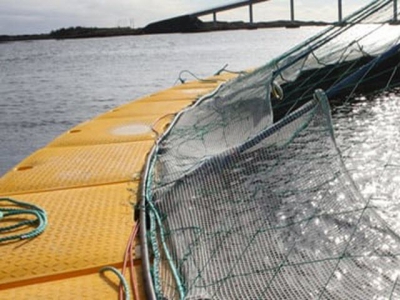The future phases of salmon production

The development of a combination of closed-containment and offshore aquaculture systems is required to ensure the salmon farming sector remains viable in the long-term – although traditional, inshore net-pens are likely to continue to play an important role.
A semi-closed-containment facilty Photo: © Reidun Lilleholt Kraugerud, Nofima
So believe Nofima’s Åsa Espmark, who is director of CtrlAQUA, a centre for research-driven innovation in closed-containment farming systems, and Sintef's Hans Bjelland, director of Exposed – an initiative looking into farming in high energy locations
Espmark believes that it won't be long until traditional net pens are joined by commercial scale sea-based closed containment facilities, land-based farms and exposed aquaculture (offshore) sites.
“I believe traditional net-pens will continue to play a central part in the future. They are definitely useful. If the net-pens are located in a place with a good water flow, it is a very favourable way of farming salmon”, says Espmark.
“The reason why we are researching closed containment facilities is that the traditional method of open-net fish farming alone will not be sustainable in the future. The fish farming industry must find alternative ways to farm salmon. Closed-containment aquaculture (CCA) will make it possible to farm salmon practically without salmon lice and escaped fish, as there will be a physical barrier between the fish and the sea so the lice cannot enter and fish cannot escape. We are now conducting research to find ways to make salmon thrive in such facilities,” she adds.
CtrlAQUA involves 21 partners from the research, fish farming and supply industry sectors, who are working together to make CCA solutions become off-the-shelf products by 2023. The solutions that the CtrlAQUA researchers are working on are land-based facilities and semi-closed facilities at sea for production of salmon of up to 1 kg.
“CtrlAQUA stops there, as it is before the weight reaches one kilogram that we can do anything significant to strengthen the robustness, health and wellbeing of the fish. The rest is, to put it simply, basically a transport stage for the fish to grow bigger,” says Espmark.
“As a salmon is approaching the target weight of five kilograms, it requires far more space than when it is small. With closed-containment farming, the total Norwegian salmon production would require enormous land areas. It would also be very energy intensive and technologically challenging to operate an onshore fish farm with pumps and salt-water recycling, as salmon should preferably live in salt water as it matures.
“I believe it will have a significant positive impact on the environment if we can reduce the amount of time the salmon spends in the sea by allowing it to spend more of its life in land-based facilities than it currently does,” she adds.
Espmark is supported by Hans Bjelland of Sintef, director of Exposed – an initiative looking into farms in high energy locations, potentially far from land. Like CtrlAQUA it is exploring opportunities for the future of aquaculture technology.
“The reasons for working with developing fish farming operations in exposed locations are that there is plenty of space; stable, good water conditions; and greater distance between each fish farming facility, which reduces the infection pressure. At the same time, ocean currents carry away fish faeces and uneaten feed,” Bjelland says.
“If we are able to let salmon grow big on land before it’s transferred to sea, we can reduce the time spent at sea from the current 16-18 months down to 10 months, which means we can also avoid the two most severe winter months. Every third salmon that escapes does so during bad weather – and bad weather is more prevalent in winter,” he adds.
Salmon that are to be transported to offshore facilities far from land must be able to endure hours of strong currents and more waves than the salmon placed in net pens in more sheltered environments.
“In the Exposed SFI [centre for research-based innovation] we are doing a great deal of research on swimming capacity and behaviour. The SFIs are complementing each other in this regard. Whereas researchers in CtrlAQUA are researching health and production efficiency in fish farming in order to produce smolt that can survive the transition to the sea, we also need even more robust smolt that can survive the transition to a more demanding open-sea environment,” says Bjelland.
Có thể bạn quan tâm
 Expedition uncovers new insights into salmon migration
Expedition uncovers new insights into salmon migration Scientists taking part in a major survey of salmonid species in the North Pacific have returned to Vancouver with a number of surprising discoveries
 Efficacy of saturated lipids in juvenile California yellowtail feeds
Efficacy of saturated lipids in juvenile California yellowtail feeds More precisely, its feeds must include adequate amounts of arachidonic acid (ARA) and docosahexaenoic acid (DHA). And also including eicosapentaenoic acid (EPA)
 Production of omega-3 enriched tilapia through dietary algae meal or fish oil
Production of omega-3 enriched tilapia through dietary algae meal or fish oil Tilapia is a healthy food choice for consumers because it is a relatively low-fat fish that is rich in proteins and minerals.